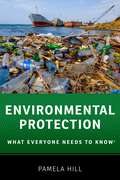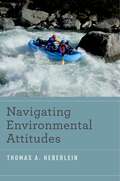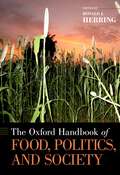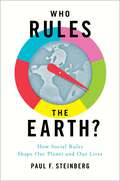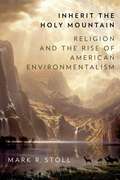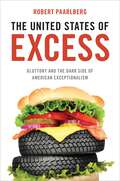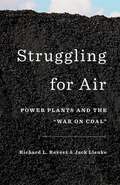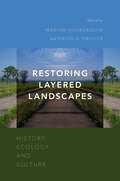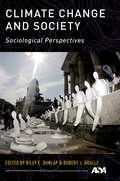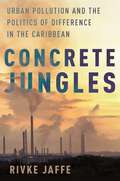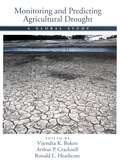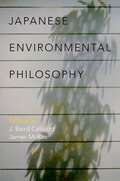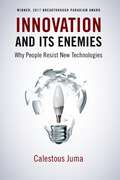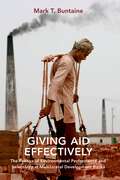- Table View
- List View
Environmental Protection: What Everyone Needs to Know® (What Everyone Needs To Know®)
by Pamela HillAlthough climate change and pollution make near-daily appearances in the news, humans have not always recognized that the environment needs to be protected. Only after the publication of Rachel Carson's Silent Spring in 1962 did environmental protection became a political and social priority. In Environmental Protection: What Everyone Needs to Know®, environmental lawyer Pamela Hill offers clear, engaging answers to some of the most pressing questions facing us today. She discusses the science behind current environmental issues, defining key terms such as ecosystems, pollutants, and endocrine disruptors. Hill explains why our environment needs protection, using examples from history and current events, from the Irish potato famine to the BP oil spill in the Gulf of Mexico and the drinking water crisis in Flint, Michigan. She also assesses the effectiveness of landmark laws and treaties, including the Clean Air Act, the Endangered Species Act, and the Kyoto Protocol. To what extent is it acceptable to rank human interests over ecological interests? And is it fair to ask developing countries to reduce emissions, even though they bear little responsibility for our current environmental problems? Hill identifies the greatest environmental threats we are facing today and suggests what we need to do as citizens, businesspeople, and lawmakers to protect the environment for each other and for future generations.
ENVIRONMENTAL PROTECTION WENK C: What Everyone Needs to Know® (What Everyone Needs To Know®)
by Pamela HillAlthough climate change and pollution make near-daily appearances in the news, humans have not always recognized that the environment needs to be protected. Only after the publication of Rachel Carson's Silent Spring in 1962 did environmental protection became a political and social priority. In Environmental Protection: What Everyone Needs to Know®, environmental lawyer Pamela Hill offers clear, engaging answers to some of the most pressing questions facing us today. She discusses the science behind current environmental issues, defining key terms such as ecosystems, pollutants, and endocrine disruptors. Hill explains why our environment needs protection, using examples from history and current events, from the Irish potato famine to the BP oil spill in the Gulf of Mexico and the drinking water crisis in Flint, Michigan. She also assesses the effectiveness of landmark laws and treaties, including the Clean Air Act, the Endangered Species Act, and the Kyoto Protocol. To what extent is it acceptable to rank human interests over ecological interests? And is it fair to ask developing countries to reduce emissions, even though they bear little responsibility for our current environmental problems? Hill identifies the greatest environmental threats we are facing today and suggests what we need to do as citizens, businesspeople, and lawmakers to protect the environment for each other and for future generations.
Navigating Environmental Attitudes
by Thomas A. HeberleinThe environment, and how humans affect it, is more of a concern now than ever. We are constantly told that halting climate change requires raising awareness, changing attitudes, and finally altering behaviors among the general public-and fast. New information, attitudes, and actions, it is conventionally assumed, will necessarily follow one from the other. But this approach ignores much of what is known about attitudes in general and environmental attitudes specifically-there is a huge gap between what we say and what we do. Solving environmental problems requires a scientific understanding of public attitudes. Like rocks in a swollen river, attitudes often lie beneath the surface-hard to see, and even harder to move or change. In Navigating Environmental Attitudes, Thomas Heberlein helps us read the water and negotiate its hidden obstacles, explaining what attitudes are, how they change and influence behavior. Rather than necessarily trying to change public attitudes, we need to design solutions and policies with them in mind. He illustrates these points by tracing the attitudes of the well-known environmentalist Aldo Leopold, while tying social psychology to real-world behaviors throughout the book. Bringing together theory and practice, Navigating Environmental Attitudes provides a realistic understanding of why and how attitudes matter when it comes to environmental problems; and how, by balancing natural with social science, we can step back from false assumptions and unproductive, frustrating programs to work toward fostering successful, effective environmental action. "With lively prose, inviting stories, and solid science, Heberlein pilots us deftly through the previously uncharted waters of environmental attitudes. It's a voyage anyone interested in environmental issues needs to take." -- Robert B. Cialdini, author of Influence: Science and Practice "Navigating Environmental Attitudes is a terrific book. Heberlein's authentic voice and the book's organization around stories keeps readers hooked. Wildlife biologists, natural resource managers, conservation biologists - and anyone else trying to solve environmental problems - will learn a lot about attitudes, behaviors, and norms; and the fallacy of the Cognitive Fix." -- Stephen Russell Carpenter, Stephen Alfred Forbes Professor of Zoology, University of Wisconsin-Madison "People who have spent their lives dealing with environmental issues from a broad range of perspectives consistently abide by erroneous assumption that all we need to do to solve environmental problems is to educate the public. I consider it to be the most dangerous of all assumptions in environmental management. In Navigating Environmental Attitudes, Tom Heberlein brings together expertise in social and biophysical sciences to do an important kind of 'science education'-educating eminent scientists about the realities of their interactions with the broader public." --the late Bill Freudenburg, Dehlsen Professor of Environment and Society, University of California, Santa Barbara
The Oxford Handbook of Food, Politics, and Society (Oxford Handbooks)
by Ronald J. HerringFood has, for most of our species history, been intensely political: who gets to eat what, how often, and through what means? The scale of polity in question has shifted over time, from very local institutions dividing up grain piles to an international community imagined in the Millennium Development Goals of the United Nations. Simultaneously, the numbers and interests of people asserting political stakes in food and agriculture have likewise shifted up and out. Global networks advocate social justice in distal agrarian systems, promotion of some farming techniques and prohibition of others, food sovereignty or efficiencies of markets and trade. Political consumerism allows the well-endowed to "vote with their dollars" for changes in food systems far from home, but depends on certification and labeling from unseen institutions. As an object of governmentality, food has never been so prominent. The thirty-five handbook chapters confront four major themes in the politics of food: property, technology, justice and knowledge. Ronald Herring's editorial introduction asks how food is political, highlighting contention around the role of market, state and information in societal decisions. The first section of the handbook then examines technology, science and knowledge in food production. What is known - and disputed - about malnutrition, poverty and food security? The second section addresses ethics, rights and distributive justice: agrarian reform, gender inequality, entitlements and subsidies, and the social vision of the alternative food movement. The third section looks to intersections of agriculture and nature: wild foods, livestock, agro-ecological approaches to sustainability, and climate change and genetic engineering. The fourth section addresses food values and culture: political consumerism, labeling and certification, the science and cultural politics of food safety, values driving regulation of genetically modified foods and potential coexistence of GMOs, and organic and conventional crops. The fifth and final section looks at frontiers of global contentions: rival transnational advocacy networks, social movements for organic farming, the who and why of international land grabbing, junctures of cosmopolitan and local food narratives, the "supermarket revolution" and the international agrifood industry in low-income countries, and politics of knowledge in agricultural futures.
Who Rules the Earth?: How Social Rules Shape Our Planet and Our Lives
by Paul F. SteinbergWorldwide, half a million people die from air pollution each year-more than perish in all wars combined. One in every five mammal species on the planet is threatened with extinction. Our climate is warming, our forests are in decline, and every day we hear news of the latest ecological crisis. What will it really take to move society onto a more sustainable path? Many of us are already doing the "little things" to help the earth, like recycling or buying organic produce. These are important steps-but they're not enough. In Who Rules the Earth?, Paul Steinberg, a leading scholar of environmental politics, shows that the shift toward a sustainable world requires modifying the very rules that guide human behavior and shape the ways we interact with the earth. We know these rules by familiar names like city codes, product design standards, business contracts, public policies, cultural norms, and national constitutions. Though these rules are largely invisible, their impact across the planet has been dramatic. By changing the rules, Ontario, Canada has cut the levels of pesticides in its waterways in half. The city of Copenhagen has adopted new planning codes that will reduce its carbon footprint to zero by 2025. In the United States, a handful of industry mavericks designed new rules to promote greener buildings, and transformed the world's largest industry into a more sustainable enterprise. Steinberg takes the reader on a series of journeys, from a familiar walk on the beach to a remote village deep in the jungles of Peru, helping the reader to "see" the social rules that pattern our physical reality and showing why these are the big levers that will ultimately determine the health of our planet. By unveiling the influence of social rules at all levels of society-from private property to government policy, and from the rules governing our oceans to the dynamics of innovation and change within corporations and communities-Who Rules the Earth? is essential reading for anyone who understands that sustainability is not just a personal choice, but a political struggle.
Inherit the Holy Mountain: Religion and the Rise of American Environmentalism
by Mark StollIn Inherit the Holy Mountain, historian Mark Stoll introduces us to the religious roots of the American environmental movement. Religion, he shows, provided environmentalists both with deeply-embedded moral and cultural ways of viewing the world and with content, direction, and tone for the causes they espoused. Stoll discovers that specific denominational origins corresponded with characteristic sets of ideas about nature and the environment as well as distinctive aesthetic reactions to nature, as can be seen in key works of art analyzed throughout the book. Stoll also provides insight into the possible future of environmentalism in the United States, concluding with an examination of the current religious scene and what it portends for the future. By debunking the supposed divide between religion and American environmentalism, Inherit the Holy Mountain opens up a fundamentally new narrative in environmental studies.
Inherit the Holy Mountain: Religion and the Rise of American Environmentalism
by Mark StollIn Inherit the Holy Mountain, historian Mark Stoll introduces us to the religious roots of the American environmental movement. Religion, he shows, provided environmentalists both with deeply-embedded moral and cultural ways of viewing the world and with content, direction, and tone for the causes they espoused. Stoll discovers that specific denominational origins corresponded with characteristic sets of ideas about nature and the environment as well as distinctive aesthetic reactions to nature, as can be seen in key works of art analyzed throughout the book. Stoll also provides insight into the possible future of environmentalism in the United States, concluding with an examination of the current religious scene and what it portends for the future. By debunking the supposed divide between religion and American environmentalism, Inherit the Holy Mountain opens up a fundamentally new narrative in environmental studies.
The United States of Excess: Gluttony and the Dark Side of American Exceptionalism
by Robert PaarlbergCompared to other wealthy countries, America stands out as a gluttonous over-consumer of both food and fuel. The United States boasts an obesity prevalence double the industrial world average, and per capita carbon emissions twice the average for Europe. Still worse, the policy steps taken by America in response to obesity and climate change have so far been the weakest in the industrial world. These aspects of America's exceptionalism are nothing to be proud of. Is it possible that America is hard-wired to consume too much food and fuel? Unfortunately, yes, says Robert Paarlberg in The United States of Excess. America's excess is driven in each case by its distinct endowment of material and demographic resources, its unusually weak national political institutions, and a unique political culture that celebrates both individual freedoms over social responsibility, and free markets over governmental authority. America's over-consumption is shown to be over-determined. Because of these powerful underlying circumstances, America's strongest policy response, both to climate change and obesity, will be adaptation rather than mitigation. As the damaging consequences of climate change become manifest, America will not impose adequate measures to reduce fossil fuel consumption, attempting instead to protect itself from storms and sea-level rise through costly infrastructure upgrades. In response to the damaging health consequences of obesity, America will opt for medical interventions and physical accommodations, rather than the policy measures that would be needed to induce better diets or more exercise. These adaptation responses will generate serious equity problems, both at home and abroad. Responding to obesity with medical interventions will fall short for those in America most prone to obesity - racial minorities and the poor - since these groups have never enjoyed adequate access to quality health care. Responding to climate change by building more resilient infrastructures at home, while allowing atmospheric concentrations of CO2 to continue their increase, will impose greater climate disruption on poor tropical countries, which are far less capable of self-protection. Awareness of these inequities must be the starting point toward altering America's current path.
An Unfinished Foundation: The United Nations and Global Environmental Governance
by Ken ConcaWhy is the United Nations not more effective on global environmental challenges? The UN Charter mandates the global organization to seek four noble aspirations: international peace and security, rule of law among nations, human rights for all people, and social progress through development. On environmental issues, however, the UN has understood its charge much more narrowly: it works for "better law between nations" and "better development within them." This approach treats peace and human rights as unrelated to the world's environmental problems, despite a large body of evidence to the contrary. In this path-breaking book, a leading scholar of global environmental governance critiques the UN's failure to use its mandates on human rights and peace as tools in its environmental work. The book traces the institutionalization and performance of the UN's "law and development" framework and the parallel silence on rights and peace. Despite some important gains, the traditional approach is failing for some of world's most pressing and contentious environmental challenges, and has lost most of the political momentum it once enjoyed. The disastrous "Rio+20" Summit laid this fact bare, as assembled governments failed to find meaningful agreement on any of the most pressing issues. By not treating the environment as a human rights issue, the UN fails to mobilize powerful tools for accountability in the face of pollution and resource degradation. And by ignoring the conflict potential around natural resources and environmental protection efforts, the UN misses opportunities to transform the destructive cycle of violence and vulnerability around resource extraction. The book traces the history of the UN's traditional approach, maps its increasingly apparent limits, and suggests needed reforms. Detailed case histories for each of the four mandate domains flag several promising initiatives, while identifying barriers to transformation. Its core implication: the UN's environmental efforts require not just a managerial reorganization but a conceptual revolution-one that brings to bear the full force of the organization's mandate. Peacebuilding, conflict sensitivity, rights-based frameworks, and accountability mechanisms can be used to enhance the UN's environmental effectiveness and legitimacy.
UNFINISHED FOUNDATION C: The United Nations and Global Environmental Governance
by Ken ConcaWhy is the United Nations not more effective on global environmental challenges? The UN Charter mandates the global organization to seek four noble aspirations: international peace and security, rule of law among nations, human rights for all people, and social progress through development. On environmental issues, however, the UN has understood its charge much more narrowly: it works for "better law between nations" and "better development within them." This approach treats peace and human rights as unrelated to the world's environmental problems, despite a large body of evidence to the contrary. In this path-breaking book, a leading scholar of global environmental governance critiques the UN's failure to use its mandates on human rights and peace as tools in its environmental work. The book traces the institutionalization and performance of the UN's "law and development" framework and the parallel silence on rights and peace. Despite some important gains, the traditional approach is failing for some of world's most pressing and contentious environmental challenges, and has lost most of the political momentum it once enjoyed. The disastrous "Rio+20" Summit laid this fact bare, as assembled governments failed to find meaningful agreement on any of the most pressing issues. By not treating the environment as a human rights issue, the UN fails to mobilize powerful tools for accountability in the face of pollution and resource degradation. And by ignoring the conflict potential around natural resources and environmental protection efforts, the UN misses opportunities to transform the destructive cycle of violence and vulnerability around resource extraction. The book traces the history of the UN's traditional approach, maps its increasingly apparent limits, and suggests needed reforms. Detailed case histories for each of the four mandate domains flag several promising initiatives, while identifying barriers to transformation. Its core implication: the UN's environmental efforts require not just a managerial reorganization but a conceptual revolution-one that brings to bear the full force of the organization's mandate. Peacebuilding, conflict sensitivity, rights-based frameworks, and accountability mechanisms can be used to enhance the UN's environmental effectiveness and legitimacy.
Struggling for Air: Power Plants and the "War on Coal"
by Richard Revesz Jack LienkeSince the beginning of the Obama Administration, conservative politicians have railed against the President's "War on Coal." As evidence of this supposed siege, they point to a series of rules issued by the Environmental Protection Agency that aim to slash air pollution from the nation's power sector . Because coal produces far more pollution than any other major energy source, these rules are expected to further reduce its already shrinking share of the electricity market in favor of cleaner options like natural gas and solar power. But the EPA's policies are hardly the "unprecedented regulatory assault " that opponents make them out to be. Instead, they are merely the latest chapter in a multi-decade struggle to overcome a tragic flaw in our nation's most important environmental law. In 1970, Congress passed the Clean Air Act, which had the remarkably ambitious goal of eliminating essentially all air pollution that posed a threat to public health or welfare. But there was a problem: for some of the most common pollutants, Congress empowered the EPA to set emission limits only for newly constructed industrial facilities, most notably power plants. Existing plants, by contrast, would be largely exempt from direct federal regulation-a regulatory practice known as "grandfathering." What lawmakers didn't anticipate was that imposing costly requirements on new plants while giving existing ones a pass would simply encourage those old plants to stay in business much longer than originally planned. Since 1970, the core problems of U.S. environmental policy have flowed inexorably from the smokestacks of these coal-fired clunkers, which continue to pollute at far higher rates than their younger peers. In Struggling for Air, Richard L. Revesz and Jack Lienke chronicle the political compromises that gave rise to grandfathering, its deadly consequences, and the repeated attempts-by presidential administrations of both parties-to make things right.
Struggling for Air: Power Plants and the "War on Coal"
by Richard Revesz Jack LienkeSince the beginning of the Obama Administration, conservative politicians have railed against the President's "War on Coal." As evidence of this supposed siege, they point to a series of rules issued by the Environmental Protection Agency that aim to slash air pollution from the nation's power sector . Because coal produces far more pollution than any other major energy source, these rules are expected to further reduce its already shrinking share of the electricity market in favor of cleaner options like natural gas and solar power. But the EPA's policies are hardly the "unprecedented regulatory assault " that opponents make them out to be. Instead, they are merely the latest chapter in a multi-decade struggle to overcome a tragic flaw in our nation's most important environmental law. In 1970, Congress passed the Clean Air Act, which had the remarkably ambitious goal of eliminating essentially all air pollution that posed a threat to public health or welfare. But there was a problem: for some of the most common pollutants, Congress empowered the EPA to set emission limits only for newly constructed industrial facilities, most notably power plants. Existing plants, by contrast, would be largely exempt from direct federal regulation-a regulatory practice known as "grandfathering." What lawmakers didn't anticipate was that imposing costly requirements on new plants while giving existing ones a pass would simply encourage those old plants to stay in business much longer than originally planned. Since 1970, the core problems of U.S. environmental policy have flowed inexorably from the smokestacks of these coal-fired clunkers, which continue to pollute at far higher rates than their younger peers. In Struggling for Air, Richard L. Revesz and Jack Lienke chronicle the political compromises that gave rise to grandfathering, its deadly consequences, and the repeated attempts-by presidential administrations of both parties-to make things right.
Restoring Layered Landscapes: History, Ecology, and Culture
Restoring Layered Landscapes brings together historians, geographers, philosophers, and interdisciplinary scholars to explore ecological restoration in landscapes with complex histories shaped by ongoing interactions between humans and nature. For many decades, ecological restoration - particularly in the United States - focused on returning degraded sites to conditions that prevailed prior to human influence. This model has been broadened in recent decades, and restoration now increasingly focuses on the recovery of ecological functions and processes rather than on returning a site to a specific historical state. Nevertheless, neither the theory nor the practice of restoration has fully come to terms with the challenges of restoring layered landscapes, where nature and culture shape one another in deep and ongoing relationships. Former military and industrial sites provide paradigmatic examples of layered landscapes. Many of these sites are not only characterized by natural ecosystems worth preserving and restoring, but also embody significant political, social, and cultural histories. This volume grapples with the challenges of restoring and interpreting such complex sites: What should we aim to restore in such places? How can restoration adequately take the legacies of human use into account? Should traces of the past be left on the landscape, and how can interpretive strategies be creatively employed to make visible the complex legacies of an open pit mine or chemical weapons manufacturing plant? Restoration aims to create new value, but not always without loss. Restoration often disrupts existing ecosystems, infrastructure, and artifacts. The chapters in this volume consider what restoration can tell us more generally about the relationship between continuity and change, and how the past can and should inform our thinking about the future. These insights, in turn, will help foster a more thoughtful approach to human-environment relations in an era of unprecedented anthropogenic global environmental change.
Love Canal: A Toxic History from Colonial Times to the Present
by Richard S. NewmanIn the summer of 1978, residents of Love Canal, a suburban development in Niagara Falls, NY, began protesting against the leaking toxic waste dump in their midst-a sixteen-acre site containing 100,000 barrels of chemical waste that anchored their neighborhood. Initially seeking evacuation, area activists soon found that they were engaged in a far larger battle over the meaning of America's industrial past and its environmental future. The Love Canal protest movement inaugurated the era of grassroots environmentalism, spawning new anti-toxics laws and new models of ecological protest. Historian Richard S. Newman examines the Love Canal crisis through the area's broader landscape, detailing the way this ever-contentious region has been used, altered, and understood from the colonial era to the present day. Newman journeys into colonial land use battles between Native Americans and European settlers, 19th-century utopian city planning, the rise of the American chemical industry in the 20th century, the transformation of environmental activism in the 1970s, and the memory of environmental disasters in our own time. In an era of hydrofracking and renewed concern about nuclear waste disposal, Love Canal remains relevant. It is only by starting at the very beginning of the site's environmental history that we can understand the road to a hazardous waste crisis in the 1970s-and to the global environmental justice movement it sparked.
Climate Change and Society: Sociological Perspectives
by Riley E. Dunlap and Robert J. BrulleClimate change is one of the most critical issues of the twenty-first century, presenting a major intellectual challenge to both the natural and social sciences. While there has been significant progress in natural science understanding of climate change, social science analyses have not been as fully developed. Climate Change and Society breaks new theoretical and empirical ground by presenting climate change as a thoroughly social phenomenon, embedded in behaviors, institutions, and cultural practices. This collection of essays summarizes existing approaches to understanding the social, economic, political, and cultural dimensions of climate change. From the factors that drive carbon emissions to those which influence societal responses to climate change, the volume provides a comprehensive overview of the social dimensions of climate change. An improved understanding of the complex relationship between climate change and society is essential for modifying ecologically harmful human behaviors and institutional practices, creating just and effective environmental policies, and developing a more sustainable future. Climate Change and Society provides a useful tool in efforts to integrate social science research, natural science research, and policymaking regarding climate change and sustainability. Produced by the American Sociological Association's Task Force on Sociology and Global Climate Change, this book presents a challenging shift from the standard climate change discourse, and offers a valuable resource for students, scholars, and professionals involved in climate change research and policy.
Concrete Jungles: Urban Pollution and the Politics of Difference in the Caribbean (Global and Comparative Ethnography)
by Rivke JaffeIn the popular imagination, the Caribbean islands represent tropical paradise. This image, which draws millions of tourists to the region annually, underlies the efforts of many environmentalists to protect Caribbean coral reefs, mangroves, and rainforests. However, a dark side to Caribbean environmentalism lies beyond the tourist's view in urban areas where the islands' poorer citizens suffer from exposure to garbage, untreated sewage, and air pollution. Concrete Jungles explores the reasons why these issues tend to be ignored, demonstrating how mainstream environmentalism reflects and reproduces class and race inequalities. Based on over a decade of research in Kingston, Jamaica and Willemstad, Curaçao, Rivke Jaffe contrasts the environmentalism of largely middle-class professionals with the environmentalism of inner-city residents. The book combines a sophisticated discussion of the politics of difference with rich ethnographic detail, including vivid depictions of Caribbean ghettos and elite enclaves. Jaffe also extends her analysis beyond ethnographic research, seeking to understand the role of colonial history in shaping the current trends in pollution and urban space. A thorough analysis of the hidden inequalities of mainstream environmentalism, Concrete Jungles provides a political ecology of urban pollution with significant implications for the future of environmentalism.
CONCRETE JUNGLES GCE C: Urban Pollution and the Politics of Difference in the Caribbean (Global and Comparative Ethnography)
by Rivke JaffeIn the popular imagination, the Caribbean islands represent tropical paradise. This image, which draws millions of tourists to the region annually, underlies the efforts of many environmentalists to protect Caribbean coral reefs, mangroves, and rainforests. However, a dark side to Caribbean environmentalism lies beyond the tourist's view in urban areas where the islands' poorer citizens suffer from exposure to garbage, untreated sewage, and air pollution. Concrete Jungles explores the reasons why these issues tend to be ignored, demonstrating how mainstream environmentalism reflects and reproduces class and race inequalities. Based on over a decade of research in Kingston, Jamaica and Willemstad, Curaçao, Rivke Jaffe contrasts the environmentalism of largely middle-class professionals with the environmentalism of inner-city residents. The book combines a sophisticated discussion of the politics of difference with rich ethnographic detail, including vivid depictions of Caribbean ghettos and elite enclaves. Jaffe also extends her analysis beyond ethnographic research, seeking to understand the role of colonial history in shaping the current trends in pollution and urban space. A thorough analysis of the hidden inequalities of mainstream environmentalism, Concrete Jungles provides a political ecology of urban pollution with significant implications for the future of environmentalism.
Monitoring and Predicting Agricultural Drought: A Global Study
by Arthur P. Cracknell Vijendra K. Boken Ronald L. HeathcoteAgricultural droughts affect whole societies, leading to higher food costs, threatened economies, and even famine. In order to mitigate such effects, researchers must first be able to monitor them, and then predict them; however no book currently focuses on accurate monitoring or prediction of these devastating kinds of droughts. To fill this void, the editors of Monitoring and Predicting Agricultural Drought have assembled a team of expert contributors from all continents to make a global study, describing biometeorological models and monitoring methods for agricultural droughts. These models and methods note the relationships between precipitation, soil moisture, and crop yields, using data gathered from conventional and remote sensing techniques. The coverage of the book includes probabilistic models and techniques used in America, Europe and the former USSR, Africa, Asia, and Australia, and it concludes with coverage of climate change and resultant shifts in agricultural productivity, drought early warning systems, and famine mitigation. This will be an essential collection for those who must advise governments or international organizations on the current scope, likelihood, and impact of agricultural droughts. Sponsored by the World Meterological Organization
Walden Pond: A History
by W. Barksdale MaynardPerhaps no other natural setting has as much literary, spiritual, and environmental significance for Americans as Walden Pond. Some 700,000 people visit the pond annually, and countless others journey to Walden in their mind, to contemplate the man who lived there and what the place means to us today. Here is the first history of the Massachusetts pond Thoreau made famous 150 years ago. W. Barksdale Maynard offers a lively and comprehensive account of Walden Pond from the early nineteenth century to the present. From Thoreau's first visit at age 4 in 1821--"That woodland vision for a long time made the drapery of my dreams"--to today's efforts both to conserve the pond and allow public access, Maynard captures Walden Pond's history and the role it has played in social, cultural, literary, and environmental movements in America. Along the way Maynard details the geography of the pond; Thoreau's and Emerson's experiences of Walden over their lifetimes; the development of the cult of Thoreau and the growth of the pond as a site of literary and spiritual pilgrimages; rock star Don Henley's Walden Woods Project and the much publicized battle to protect the pond from developers in the 1980s; and the vitally important ecological symbol Walden Pond has become today. Exhaustively researched, vividly written, and illustrated with historical photographs and the most detailed maps of Thoreau country yet created, Walden Pond: A History reveals how an ordinary pond has come to be such an extraordinarily inspiring symbol.
Japanese Environmental Philosophy
by J. Baird Callicott James McRaeJapanese Environmental Philosophy is an anthology that responds to the environmental problems of the 21st century by drawing from Japanese philosophical traditions to investigate our relationships with other humans, nonhuman animals, and the environment. It contains chapters from fifteen top scholars from Japan, the United States, and Europe. The essays cover a broad range of Japanese thought, including Zen Buddhism, Shintoism, the Kyoto School, Japanese art and aesthetics, and traditional Japanese culture.
Stories from the Leopold Shack: Sand County Revisited
by Estella B. LeopoldIn 1934, conservationist Aldo Leopold and his wife Estella bought a barn - the remnant of a farm - and surrounding lands in south-central Wisconsin. The entire Leopold clan - five children in all - worked together to put into practice Aldo's "land ethic," which involved ecological restoration and sustainability. In the process, they built more than a pleasant weekend getaway; they established a new way of relating to nature. In 1948, A Sand County Almanac was published, and it has become a beloved and foundational text of the conservation movement. Decades later, Estella B. Leopold, the youngest of the Leopold children - she was eight when they bought the land - now reflects on the "Shack," as they called the repurposed barn, and its inhabitants, and recalls with clear-eyed fondness the part it played in her and her siblings' burgeoning awareness of nature's miracles, season by season. In Stories from the Leopold Shack: Sand County Revisited, she unforgettably recalls the intensity of those days: the taste of fresh honey on sourdough pancakes; the trumpeting arrival of migrating Canada geese; the awesome power of river ice driven by currents - and each description is accompanied by stunning photographs by her brother, A. Carl Leopold. As the Leopolds worked to restore degraded farmland back to its original prairie and woods, they noted and celebrated all of the flora and fauna that came to share the Shack lands. As first evoked in A Sand County Almanac, and now revisited in Stories from the Leopold Shack, the Leopold family's efforts of ecological restoration were among the earliest in the United States, and their work, collectively and individually, continues to have a profound impact on land management and conservationism. All of Aldo and Estella Leopold's children went on to become distinguished scientists and to devote themselves to a life of conservation; their work continues through the Aldo Leopold Foundation. Estella B. Leopold book offers a voyage back to the place where it all began.
Stories from the Leopold Shack: Sand County Revisited
by Estella B. LeopoldIn 1934, conservationist Aldo Leopold and his wife Estella bought a barn - the remnant of a farm - and surrounding lands in south-central Wisconsin. The entire Leopold clan - five children in all - worked together to put into practice Aldo's "land ethic," which involved ecological restoration and sustainability. In the process, they built more than a pleasant weekend getaway; they established a new way of relating to nature. In 1948, A Sand County Almanac was published, and it has become a beloved and foundational text of the conservation movement. Decades later, Estella B. Leopold, the youngest of the Leopold children - she was eight when they bought the land - now reflects on the "Shack," as they called the repurposed barn, and its inhabitants, and recalls with clear-eyed fondness the part it played in her and her siblings' burgeoning awareness of nature's miracles, season by season. In Stories from the Leopold Shack: Sand County Revisited, she unforgettably recalls the intensity of those days: the taste of fresh honey on sourdough pancakes; the trumpeting arrival of migrating Canada geese; the awesome power of river ice driven by currents - and each description is accompanied by stunning photographs by her brother, A. Carl Leopold. As the Leopolds worked to restore degraded farmland back to its original prairie and woods, they noted and celebrated all of the flora and fauna that came to share the Shack lands. As first evoked in A Sand County Almanac, and now revisited in Stories from the Leopold Shack, the Leopold family's efforts of ecological restoration were among the earliest in the United States, and their work, collectively and individually, continues to have a profound impact on land management and conservationism. All of Aldo and Estella Leopold's children went on to become distinguished scientists and to devote themselves to a life of conservation; their work continues through the Aldo Leopold Foundation. Estella B. Leopold book offers a voyage back to the place where it all began.
Innovation and Its Enemies: Why People Resist New Technologies
by Calestous JumaIt is a curious situation that technologies we now take for granted have, when first introduced, so often stoked public controversy and concern for public welfare. At the root of this tension is the perception that the benefits of new technologies will accrue only to small sections of society, while the risks will be more widely distributed. Drawing from nearly 600 years of technology history, Calestous Juma identifies the tension between the need for innovation and the pressure to maintain continuity, social order, and stability as one of today's biggest policy challenges. He reveals the extent to which modern technological controversies grow out of distrust in public and private institutions and shows how new technologies emerge, take root, and create new institutional ecologies that favor their establishment in the marketplace. Innovation and Its Enemies calls upon public leaders to work with scientists, engineers, and entrepreneurs to manage technological change and expand public engagement on scientific and technological matters.
Innovation and Its Enemies: Why People Resist New Technologies
by Calestous JumaIt is a curious situation that technologies we now take for granted have, when first introduced, so often stoked public controversy and concern for public welfare. At the root of this tension is the perception that the benefits of new technologies will accrue only to small sections of society, while the risks will be more widely distributed. Drawing from nearly 600 years of technology history, Calestous Juma identifies the tension between the need for innovation and the pressure to maintain continuity, social order, and stability as one of today's biggest policy challenges. He reveals the extent to which modern technological controversies grow out of distrust in public and private institutions and shows how new technologies emerge, take root, and create new institutional ecologies that favor their establishment in the marketplace. Innovation and Its Enemies calls upon public leaders to work with scientists, engineers, and entrepreneurs to manage technological change and expand public engagement on scientific and technological matters.
Giving Aid Effectively: The Politics of Environmental Performance and Selectivity at Multilateral Development Banks
by Mark T. BuntaineInternational organizations do not always live up to the expectations and mandates of their member countries. One of the best examples of this gap is the environmental performance of multilateral development banks, which are tasked with allocating and managing approximately half of all development assistance worldwide. In the 1980s and 1990s, the multilateral development banks came under severe criticism for financing projects that caused extensive deforestation, polluted large urban areas, displaced millions of people, and destroyed valuable natural resources. In response to significant and public failures, member countries established or strengthened administrative procedures, citizen complaint mechanisms, project evaluation, and strategic planning processes. All of these reforms intended to close the gap between the mandates and performance of the multilateral development banks by shaping the way projects are approved. Giving Aid Effectively provides a systematic examination of whether these efforts have succeeded in aligning allocation decisions with performance. Mark T. Buntaine argues that the most important way to give aid effectively is selectivity - moving towards projects with a record of success and away from projects with a record of failure for individual recipient countries. This book shows that under certain circumstances, the control mechanisms established to close the gap between mandate and performance have achieved selectivity. Member countries prompt the multilateral development banks to give aid more effectively when they generate information about the outcomes of past operations and use that information to make less successful projects harder to approve or more successful projects easier to approve. This argument is substantiated with the most extensive analysis of evaluations across four multilateral development banks ever completed, together with in-depth case studies and dozens of interviews. More generally, Giving Aid Effectively demonstrates that member countries have a number of mechanisms that allow them to manage international organizations for results.
